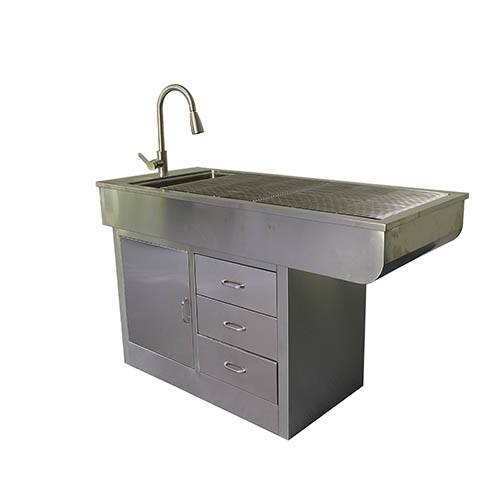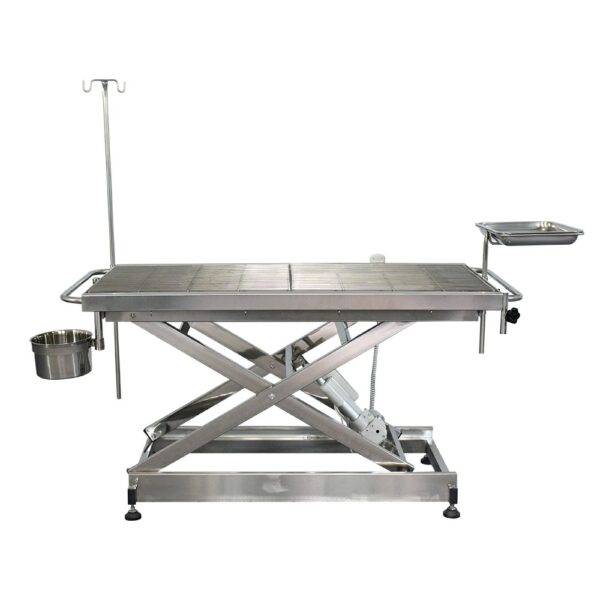Adresse
304, rue Cardinal Nord
Centre Dorchester, MA 02124
Heures de travail
Du lundi au vendredi : 7h - 19h
Week-end : 10h - 17h
Choisir la bonne table d'opération est une décision cruciale pour tout cabinet vétérinaire. Pièce maîtresse du bloc opératoire, elle influence l'efficacité du flux de travail, l'ergonomie du personnel, le positionnement du patient et les résultats chirurgicaux. Face à la multitude de modèles disponibles sur le marché, aux designs, capacités de charge et fonctionnalités variés, il peut être difficile de choisir la table qui vous convient. table d'opération vétérinaire correspond le mieux à vos besoins et à votre budget.
Cet article de blog passe en revue les 10 principales caractéristiques à prendre en compte lors de l'achat d'une table d'opération vétérinaire. Comprendre ces aspects clés vous aidera à investir dans une table durable et performante, adaptée à votre charge de travail et à vos interventions chirurgicales. Poursuivez votre lecture pour découvrir les facteurs à comparer, tels que les systèmes de levage, les surfaces, le rangement, les accessoires et bien plus encore, lors de l'achat d'une nouvelle table d'opération vétérinaire.

La première question importante est de savoir si vous avez besoin d'une table d'opération avec un système de levage motorisé ou hydraulique manuel. Les systèmes de levage électriques permettent un réglage précis de la hauteur par simple pression sur un bouton ou une pédale. Les chirurgiens peuvent ainsi lever ou abaisser la table rapidement pour une meilleure ergonomie sans perturber le champ stérile. Les systèmes de levage manuels sont plus abordables, mais n'offrent pas la flexibilité et la commodité des systèmes électriques.
| Taper | Avantages | Inconvénients |
| Électrique | Ajustements précis à la demande, meilleur flux de travail | Plus cher, formation requise |
| Manuel | Peu coûteux, aucune électronique ni formation nécessaire | Ajustements limités, flux de travail plus lent |
Lors du choix entre un ascenseur électrique ou manuel tables d'opération vétérinairesTenez compte de votre budget, de la durée moyenne des interventions et du nombre d'interventions. Les lève-personnes électriques améliorent l'efficacité, mais nécessitent un investissement initial plus important.

Tables d'opération Différentes capacités de charge maximale sont prévues. Les tables standard pour grands animaux supportent entre 450 et 680 kg, tandis que les modèles spéciaux supportent jusqu'à plus de 2700 kg pour les gros animaux. Pour les cabinets mixtes, privilégiez une table d'opération vétérinaire bariatrique conçue pour supporter au moins 225 kg pour les grands chiens. Le poids maximal doit être réparti sur la surface de la table. Vérifiez attentivement la capacité de la table pour vous assurer qu'elle peut accueillir vos patients. Dépasser les limites de poids présente un risque de blessure pour le personnel et les animaux.
Le matériau recouvrant la table d'opération a un impact significatif sur sa fonctionnalité. Parmi les options courantes, on trouve :
Acier inoxydable – Durable et facile à désinfecter, mais froid pour les patients
Résine phénolique – Plus chaude et plus confortable mais sujette aux rayures
Coussinets en gel – Offrent amorti et chaleur, mais sont difficiles à désinfecter complètement
Tenez compte du positionnement et des besoins de réchauffement du patient lors de l'évaluation des matériaux de surface. Pour la plupart des interventions, la résine phénolique ou l'acier inoxydable avec coussinets de gel offrent la meilleure combinaison entre prévention des infections, facilité d'utilisation et confort du patient.






La position de Trendelenburg incline la table d'opération pour surélever l'arrière-train du patient au-dessus de la tête et du thorax. La gravité facilite ainsi l'exposition et les interventions chirurgicales. Les tables d'opération vétérinaires à élévation électrique sont souvent équipées d'un système de positionnement Trendelenburg motorisé, actionnable par pédale ou par bouton jusqu'à 30 degrés. Les tables manuelles nécessitent une inclinaison physique du personnel.
Le mode Trendelenburg est particulièrement utile pour les interventions telles que les splénectomies, les gastropexies et les résections du côlon. Si vous pratiquez régulièrement des chirurgies abdominales, investir dans un système d'inclinaison électrique optimisé pour la maniabilité des grands animaux peut considérablement améliorer l'efficacité chirurgicale.
Le suivi des niveaux de liquide et des pertes sanguines des patients est essentiel lors de toute intervention chirurgicale majeure. Si les balances externes permettent de surveiller le poids, les tables d'opération vétérinaires les plus avancées sont équipées de systèmes de pesée intégrés affichant les données de poids en temps réel. Cela permet au personnel d'observer les tendances et de réagir rapidement en cas de pertes.
Lorsque vous examinez les tables d'opération vétérinaires, recherchez des modèles dotés de :
Capteurs de cellules de charge dans le système de levage
Affichage numérique du poids visible par les chirurgiens
Fonctionnalité tare/zéro pour isoler les changements
Connectivité sans fil pour transférer les enregistrements
Bien que les balances intégrées ajoutent de la complexité et des coûts, les avantages pour les soins aux patients justifient souvent leur valeur.
Les tables d'opération sont disponibles en modèles fixes, fixés au sol de manière permanente, ou en tables mobiles équipées de roulettes. Les modèles mobiles offrent une grande flexibilité pour transporter les patients anesthésiés des zones de préparation directement au bloc opératoire. Cependant, les bases mobiles doivent être solidement verrouillées pendant l'intervention pour une stabilité maximale.
Voici une comparaison des configurations de tables d'opération fixes et mobiles :
| Taper | Avantages | Inconvénients |
| Stationnaire | Stabilité à toute épreuve, coût réduit | Moins de flexibilité pour le transport des patients |
| Mobile | Déplacez facilement les patients, reconfigurez les chambres | Plus cher, moins stable |
Évaluez l’agencement de votre espace de travail et le flux de patients entre les espaces lorsque vous choisissez entre des options de table d’opération vétérinaire fixe ou mobile.
Les tables d'opération vétérinaires les plus récentes intègrent des compartiments de rangement et des étagères à la base. Cela permet d'accéder facilement aux fournitures chirurgicales, aux liquides, aux compresses/champs réutilisables et autres articles essentiels sans quitter le champ stérile.
Lorsque vous comparez les modèles de tables d'opération vétérinaires, recherchez les fonctionnalités de stockage suivantes :
Grande capacité intérieure et portes d'accès
Étagères et compartiments réglables
Tiroirs personnalisables pour instruments
Rangement s'étendant sur toute la longueur de la base
Bien que le stockage intégré nécessite un encombrement plus important, le flux de travail et l'efficacité organisationnelle rendent souvent le compromis intéressant pour les cabinets très occupés.
Les interventions orthopédiques et neurochirurgicales spécialisées nécessitent des dimensions et des possibilités de réglage plus importantes. De nombreuses tables d'opération vétérinaires à élévation électrique avancée proposent des accessoires d'extension orthopédiques modulaires permettant de personnaliser les dimensions de la surface et de réduire la pression exercée sur le personnel. Parmi les options courantes, on trouve :
Extensions d'imagerie – Bras en porte-à-faux supportant le poids des extrémités pour un meilleur accès à la radiographie
Extensions de montée et de descente – Supports d'ailes réglables pour éliminer les membres pendants
Tables de fracture – Plateformes orthopédiques réglables permettant une manipulation des membres à 360°
Passez en revue les modules d’extension disponibles et la compatibilité de l’imagerie pour les procédures que vous effectuez lorsque vous comparez les tables d’opération vétérinaires.
Maintenir une température corporelle normale pendant une anesthésie prolongée est essentiel. Les tables d'opération peuvent être équipées de coussins chauffants conducteurs, reliés à des tuyaux d'eau chaude, qui passent sous la table ou se fixent directement sous celle-ci. Cela permet de prévenir l'hypothermie en reproduisant la température corporelle normale du patient sous sédation.
Lorsque vous examinez les tables d'opération, recherchez des modèles dotés de :
Grandes surfaces de chauffe pour un bon transfert de chaleur
Réglages de température et coupures réglables
Compatibilité avec les pompes à eau chaude standard
Tuyaux et raccords à déconnexion rapide
Les coussins chauffants ajoutent de la complexité et du volume physique, alors tenez également compte des besoins en fonction de la durée de vos procédures habituelles et des types de patients.
Comme pour tout investissement majeur en équipement, assurez-vous d'évaluer soigneusement la qualité de fabrication, les matériaux, la quincaillerie, les accessoires et les conditions de garantie lors de vos recherches sur les tables d'opération vétérinaires. Les principaux indicateurs de durabilité sont :
Construction en acier inoxydable
Cadres revêtus de poudre
Boîtiers d'actionneurs de levage solides
Surfaces de table haute densité
Période de garantie et garanties sur les pièces de rechange
Évitez les modèles importés bon marché, qui risquent de se cabosser, de se plier ou de se casser plus facilement sous l'effet de charges lourdes répétées. Investir davantage à l'achat d'une table robuste de qualité professionnelle, fabriquée localement ou en Europe, garantit sécurité, fiabilité et longévité.
Investir dans une nouvelle table d'opération vétérinaire permet aux cabinets en pleine croissance d'améliorer leurs capacités, d'obtenir de meilleurs résultats chirurgicaux, de réduire la fatigue du personnel et d'optimiser l'efficacité globale du flux de travail. Gardez à portée de main ce top 10 des caractéristiques clés lorsque vous comparez différents modèles de différentes marques et gammes de prix. Recherchez des caractéristiques telles que les systèmes de levage électrique, les hauteurs ergonomiques, les modules d'accessoires, le rangement et le réchauffement intégré du patient qui correspondent le mieux à la gamme de cas et d'interventions spécifiques de votre cabinet. Face à la multitude d'options disponibles, prenez le temps d'évaluer les facteurs clés qui justifient un investissement important. L'attention portée à ces détails vous permettra de choisir la table d'opération vétérinaire idéale, adaptée à vos besoins spécifiques, tout en garantissant un retour sur investissement durable grâce à une meilleure prise en charge des patients.
Le prix des tables d'opération vétérinaires varie considérablement, allant d'environ 3 000 £ pour les modèles manuels d'entrée de gamme à plus de 15 000 £ pour les tables élévatrices électriques entièrement équipées, avec rangements, accessoires et autres fonctionnalités haut de gamme. Un budget réaliste pour les tables électriques se situe généralement entre 8 000 £ et 12 000 £.
Pour des raisons d'accessibilité, de facilité d'utilisation et en cas d'urgence, prévoyez un espace libre d'au moins 91 cm (36 po) de chaque côté de la base de la table d'opération. Cela offre au personnel suffisamment d'espace pour manœuvrer, ajuster la hauteur, ouvrir les rangements et se déplacer rapidement latéralement si nécessaire.
Recherchez des tables d'opération testées selon les normes internationales CEI 60601-2-46 relatives à l'ergonomie, la sécurité électrique, la compatibilité électromagnétique, la réduction des risques, les matériaux, l'étiquetage et le contrôle des infections. Ces exigences contribuent à minimiser les risques et à garantir des performances optimales.
Acheter un produit reconditionné permet de réaliser des économies substantielles. Mais pour un équipement vétérinaire aussi essentiel, privilégiez l'achat d'un produit neuf auprès de revendeurs réputés qui proposent une assistance à l'installation, une garantie, des accessoires et des conseils pour adapter les capacités de la table à vos besoins spécifiques.
